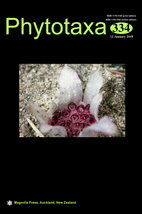Abstract
Dendrobium libingtaoi is described from southeastern Yunnan, China, based on morphological and DNA evidence. In the morphological analysis, D. libingtaoi is similar to D. draconis but differs in having ovate-elliptical petals, a lip with a light red blotch in the middle, oblong-lanceolate lateral sepals, and a nearly round midlobe. Nuclear and plastid DNA analyses indicate that D. libingtaoi is a member of D. section Formosae.

